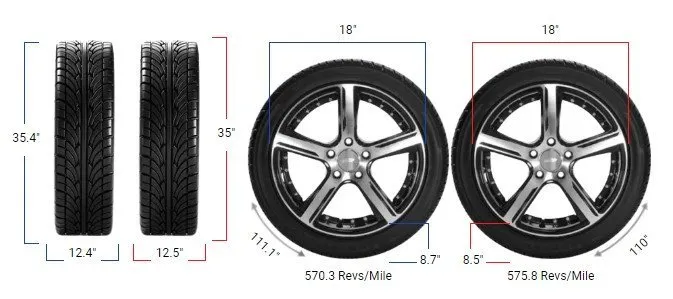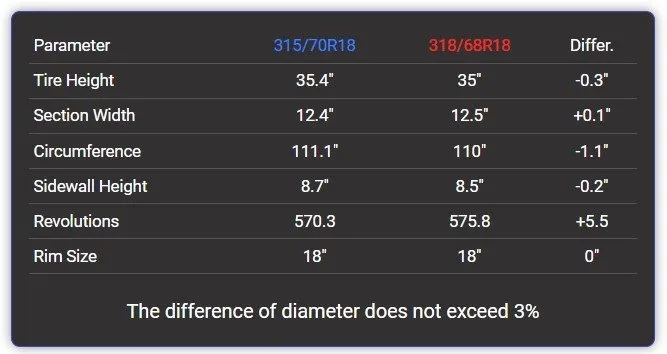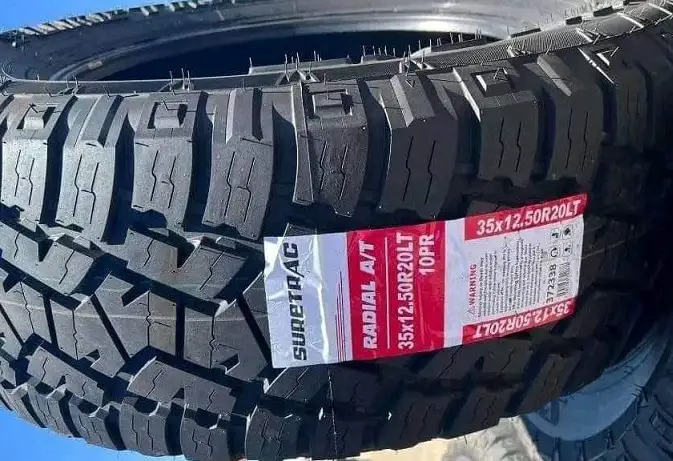Tire Size 315/70r18 vs 35×12.50r18

The main difference between 315/70r18 and 35×12.50r18 tires lies in their section width. These subtle differences influence how each tire interacts with the road, the vehicle’s aerodynamics, and even the speedometer accuracy.
- Minor changes in tire size may impact speedometer accuracy
- Slight decrease in ground clearance due to reduced diameter
- Potential improvements in handling and stability with lower sidewall height
315/70r18 vs 35×12.50r18

Fitment Guide
The 315/70r18 tire has a 0.9% smaller diameter than the 35×12.50r18. Replacement tires should be within 3% of the original size to avoid issues.
The 35×12.50r18 may require modifications like a lift kit to fit correctly and prevent rubbing.

Ground Clearance
The 35×12.50r18 provides 0.34 inches more ground clearance than the 315/70r18 due to its larger diameter. This added clearance is excellent for off-roading by helping prevent scrapes over obstacles.
However, the larger size also causes a lower speedometer reading. The 315/70r18’s reduced clearance increases the risks of scraping but gives a higher speedometer reading.
Gas Mileage
The 315/70r18’s smaller contact patch and rotational mass offer slightly better fuel efficiency than the heavier 35×12.50r18. Larger, heavier tires have more rolling resistance, detracting from gas mileage.
Ride Comfort
The 35×12.50r18 provides a smoother ride off-road with its taller sidewall cushioning bumps. But the 315/70r18 feels more responsive on pavement. Both deliver comfortable rides for their intended uses.

Aesthetics
The 35×12.50r18 has a taller sidewall, giving a stretched, aggressive look that suits trucks and SUVs. The 315/70r18 looks slightly more low-profile, benefiting aerodynamics. Either can fit a vehicle’s aesthetic.
Handling & Stability
The 315/70r18’s shorter sidewall enhances handling precision on pavement but with a bit less stability off-road. The 35×12.50r18 has more flex for traction off-road but isn’t as nimble on-road. Both offer responsive handling.
Noise & Vibration
The 315/70r18 transmits more road noise and vibration with its stiff sidewall. The 35×12.50r18’s flexible sidewall absorbs shocks, reducing vibrations. But noise levels are similar, and both ride quietly.
Durability & Wear
The 315/70r18 exhibits more even tread wear with its smaller size and weight. The heavier 35×12.50r18 endures more impact off-road but causes more drivetrain wear over time. Both last long with proper maintenance.
Adverse Conditions
The narrower 315/70r18 cuts through the snow for better traction, while the wider 35×12.50r18 provides superior performance in mud. Both handle rain and light snow well.
Speedometer Difference
At 20 mph actual speed, the 315/70r18 reads 20 mph on the speedometer. But the larger 35×12.50r18 reads 19.81 mph at the same actual speed, a difference of 0.19 mph between the tire sizes.
Can I Use 35×12.5r18 Instead of 315/70r18?
Yes, it is possible to use 35×12.5r18 tires instead of 315/70r18 tires. The difference in diameter between the two sizes is only 0.9%, which falls within the generally accepted range of 3% difference.
However, it’s essential to keep in mind that the minor differences in size may slightly affect factors such as speedometer accuracy, handling, and clearance.
How Much Taller Is a 315/70r18 Tire Than a 35×12.5r18?
When comparing the heights of the two tire sizes, a 315/70r18 tire stands approximately 0.34 inches (8.52 mm) taller than a 35×12.5r18 tire.
How Much Wider is a 35×12.5r18 Tire Than a 315/70r18?
In terms of width, a 35×12.5r18 tire is approximately 0.12 inches (3 mm) wider than a 315/70r18 tire.
What Does 35×12.50r18 Mean?
The “35×12.50r18” specification refers to tire dimensions: “35” indicates the tire’s diameter in inches, “12.50” is the tire’s width in inches, and “18” denotes the wheel rim’s diameter in inches that the tire is designed to fit.
35×12.50r18 Equivalent
The A 35×12.50R18 tire has an equivalent size of approximately 315/70R18. Both sizes have a similar diameter but may vary slightly in width and aspect ratio.
This equivalence allows for a comparable replacement option for vehicles requiring this tire size.
Our Observation
Upon reviewing the differences between these two popular truck tire sizes, we observed that the performance distinctions are quite minor. With only a 0.34-inch diameter difference, these tire sizes are more alike than they are different.
Factors like ride comfort, handling, noise, and capability are all very close between the 315/70r18 and 35×12.50r18. Fuel economy slightly favors the 35×12.50r18, while the 315/70r18 provides a bit more ground clearance.
But overall, drivers are unlikely to notice major real-world performance differences between these two sizes. The slight variance in diameter results in near equivalent behavior both on and off-road.

Meet Caitlin McCormack, a Tire Size Expert and Blogger Passionate About Everything Related to Tires. With Years of Experience in the Tire Industry, Caitlin Has Become an Expert in Tire Sizes and Their Impact on Vehicle Performance.
